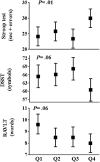Nocturnal Blood Pressure in Young Adults and Cognitive Function in Midlife: The Coronary Artery Risk Development in Young Adults (CARDIA) Study
- PMID: 25783740
- PMCID: PMC4580541
- DOI: 10.1093/ajh/hpv028
Nocturnal Blood Pressure in Young Adults and Cognitive Function in Midlife: The Coronary Artery Risk Development in Young Adults (CARDIA) Study
Abstract
Background: Nocturnal blood pressure (BP) is associated with risk for cardiovascular events. However, the relationship between nocturnal BP in young adults and cognitive function in midlife remains unclear.
Methods: We used data from the ambulatory BP monitoring substudy of the Coronary Artery Risk Development in Young Adults Study, including 224 participants (mean age 30 years, 45% men, 63% African Americans). At the 20-year follow-up, the Stroop test (executive function), Digit Symbol Substitution Test (psychomotor speed), and Rey Auditory Verbal Learning Test (verbal memory) were assessed.
Results: Baseline mean office, daytime, and nocturnal BP were 109/73, 120/74, and 107/59 mm Hg, respectively. Nocturnal BP dipping, calculated as (nocturnal systolic BP [SBP]--daytime SBP) × 100/daytime SBP, was divided into quartiles (Q1: -39.3% to -16.9%; Q2: -16.8% to -13.2%, Q3 [reference]: -13.1% to -7.8%, and Q4: -7.7% to +56.4%). In multiple regression analyses, the least nocturnal SBP dipping (Q4 vs. reference) and higher nocturnal diastolic BP level were associated with worse Stroop scores, with adjustments for demographic and clinical characteristics, and cumulative exposure to office BP during follow-up (β [standard error]: 0.37 [0.18] and 0.19 [0.07], respectively; all P < 0.05). Digit Symbol Substitution Test and Rey Auditory Verbal Learning Test were not significantly associated with nocturnal SBP dipping or nocturnal SBP/diastolic BP levels.
Conclusions: Among healthy young adults, less nocturnal SBP dipping and higher nocturnal diastolic BP levels were associated with lower executive function in midlife, independent of multiple measures of office BP during long-term follow-up.
Keywords: blood pressure; cognitive function; hypertension; midlife; nocturnal blood pressure; young adults..
© American Journal of Hypertension, Ltd 2015. All rights reserved. For Permissions, please email: journals.permissions@oup.com.
Figures

References
-
- Gorelick PB, Scuteri A, Black SE, Decarli C, Greenberg SM, Iadecola C, Launer LJ, Laurent S, Lopez OL, Nyenhuis D, Petersen RC, Schneider JA, Tzourio C, Arnett DK, Bennett DA, Chui HC, Higashida RT, Lindquist R, Nilsson PM, Roman GC, Sellke FW, Seshadri S; American Heart Association Stroke Council, Council on Epidemiology and Prevention, Council on Cardiovascular Nursing, Council on Cardiovascular Radiology and Intervention, and Council on Cardiovascular Surgery and Anesthesia. Vascular contributions to cognitive impairment and dementia: a statement for healthcare professionals from the american heart association/american stroke association. Stroke 2011; 42:2672–2713. - PMC - PubMed
-
- Kalaria RN. Cerebrovascular disease and mechanisms of cognitive impairment: evidence from clinicopathological studies in humans. Stroke 2012; 43:2526–2534. - PubMed
-
- Goldstein IB, Bartzokis G, Guthrie D, Shapiro D. Ambulatory blood pressure and the brain: a 5-year follow-up. Neurology 2005; 64:1846–1852. - PubMed
-
- White WB, Wolfson L, Wakefield DB, Hall CB, Campbell P, Moscufo N, Schmidt J, Kaplan RF, Pearlson G, Guttmann CR. Average daily blood pressure, not office blood pressure, is associated with progression of cerebrovascular disease and cognitive decline in older people. Circulation 2011; 124:2312–2319. - PMC - PubMed
Publication types
MeSH terms
Grants and funding
- HHSN268201300026C/HL/NHLBI NIH HHS/United States
- HHSN268201300027C/HL/NHLBI NIH HHS/United States
- K23AG040278/AG/NIA NIH HHS/United States
- HHSN268201300025C/HL/NHLBI NIH HHS/United States
- UL1 TR001422/TR/NCATS NIH HHS/United States
- ImNIH/Intramural NIH HHS/United States
- K23 AG040278/AG/NIA NIH HHS/United States
- P30DK092926/DK/NIDDK NIH HHS/United States
- HHSN268201300029C/HL/NHLBI NIH HHS/United States
- R01 HL098604/HL/NHLBI NIH HHS/United States
- P30 DK092926/DK/NIDDK NIH HHS/United States
- AG0005/AG/NIA NIH HHS/United States
- HHSN268200900041C/HL/NHLBI NIH HHS/United States
- HHSN268201300028C/HL/NHLBI NIH HHS/United States
LinkOut - more resources
Full Text Sources
Other Literature Sources
Molecular Biology Databases

